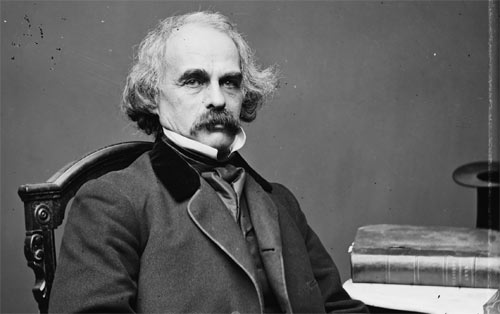The Scarlet Letter Quartet
Out to Pastoral
by John Idol
BURLINGTON North Carolina—(Weekly Hubris)—3/28/11—Among American novelists I have taught most frequently and esteem highly, none stands higher than Nathaniel Hawthorne. Since coming upon “Dr. Heidegger’s Experiment” and “The Birth-Mark” as a 10th-grader, I have enjoyed reading, teaching, and writing about his work. As president of the Nathaniel Hawthorne Society and, for nine years, the editor of the Nathaniel Hawthorne Review, I gladly labored in his vineyard throughout my years at Clemson University and for many years, in my retirement, as an instructor in Duke University’s adult education program.
My course in the 19th Century American Novel at Clemson had big guns, Hawthorne, Melville, Mark Twain, and James, plus some of smaller bore, Stowe, Howells, Cooper, and Chopin. To allow some other writers to fire their own shot, I sometimes included in my roll call Simms, John Pendleton Kennedy, and Poe. Had my department head wanted a little extra income for the English Department, I would have paid to teach the course, especially if I could have found a way to disburse my psychic income.

A major source of that income was The Scarlet Letter. It spoke in so many ways to the issues of our times that it stirred lively discussions: remaining traces of Puritanism in American society, single motherhood, sadism, masochism, the sexual shenanigans of preachers such as Jimmy Swaggart and Jim Bakker, the cost of revenge, the need for confession and truthfulness. And, of course, the issue of adultery was bound to come in a college located near the buckle of The Bible Belt, Greenville, South Carolina.
The joy of serving Hawthorne in the classroom spilled over into my research and publications. One research project, how Hawthorne used the visual arts in his fiction, led to a closer relationship with my Clemson colleague, Skip Eisiminger, and Rita Gollin, of the Geneseo campus of the State University of New York, and the publication of Prophetic Pictures: Nathaniel Hawthorne’s Knowledge and Uses of the Visual Arts (Greenwood Press, 1991). Skip’s expertise in painting was a godsend (http://www.questia.com/library/book/prophetic-pictures-nathaniel-hawthornes-knowledge-and-uses-of-the-visual-arts-by-sterling-k-eisiminger-rita-k-gollin-john-l-idol-jr.jsp).
Skip and I worked together half a dozen years on the Nathaniel Hawthorne Review, his role being associate editor. While we carried out our roles as editors, we launched another project—discovering the names of composers who had transformed Hawthorne’s fiction into opera. The project involved gathering scores and letters from composers, finally resulting in a large box of material but no monograph. The contents of the box are now in the Hawthorne-Longfellow Library at Bowdoin College, if anyone is looking to complete our unfinished labors.
Aside from Hawthornean research, we shared in interest in our common German ancestry, the exploration of which led to the discovery that our German forebears had arrived a year apart in Pennsylvania aboard the St. Andrews, the captain of which was James Abercrombie. If our library had had a beer garden, we would have rushed outside to toast the good captain and the adventurous young men who crossed the Atlantic with him. Skip’s name still looks Germanic; mine doesn’t, Eitel having been Americanized to Idol.
But we shared more than a German heritage—a passion for softball (the subject of a future essay) and a delight in crafting poems. Skip proved to be a far better poet than I. Yet, I have had fun trying my hand at various forms. Now, finally, all this brings me back to the title of my present essay and to Hawthorne.
It occurred to me one day that I might link my research into operas based on Hawthorne to humorous verse strung together as a quartet involving the four principal figures of The Scarlet Letter. When the thought hit me, I bowed humbly to John Updike, whose trilogy inspired by the romance resulted in novels featuring modern-day counterparts of Arthur Dimmesdale, A Month of Sundays; Roger Chillingsworth, Roger’s Version; and Hester Prynne, S—all sources of humor and probing evaluations of late-20th-century behavior, especially sexual.
As a vehicle for my own fun with the romance, I corrupted the form of the limerick:
The Scarlet Letter Quartet
By John Idol
“The Wimpish Lover”
The man who did it was Dimmesdale—
just where’s not part of the tale.
He thought it OK
Ms. Hester to lay,
but after he turned ashen pale.
“The Impish Daughter”
Their impish young daughter named Pearl
proved quite an impertinent girl.
Her mother, poor Hester,
she daily would pester:
“Is my father named Arthur or Earl?”
“The Avenging Husband”
Said Roger, a doctor of sorts,
“My young wife had pulled down her shorts.
It’s quite plain to see
Pearl looks nothing like me—
And I have no patience for torts.”
“The Musing Wife”
“Good God, how long must I pay
for just once going astray?
It got me a letter
and now I think better,
but, God, that sure was some lay!”
2 Comments
seisiminger
Hans, You give me far more credit than I deserve.
You were always the “better craftsman” and pitcher.
Skip
alzheimer parkinson norton yesavage pfeiffer
Its like you read my thoughts! You seem to understand a lot about this, like you wrote the e-book in it or something.
I feel that you just can do with some percent
to pressure the message house a bit, but instead of that, that is great blog.
An excellent read. I will definitely be back.